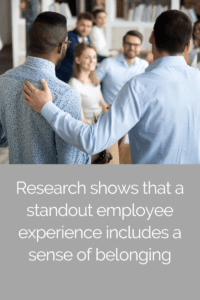Latest in workforce science reveals four investment areas for optimized EX program design and results
By Zee Johnson
Organizations are always looking for new and innovative ways to put an end to attrition and attract stellar employees. One key factor to building a sustainable workforce is to deliver an exceptional employee experience from even before the person starts a role–and it’s up to the organization to get it right.
“When we speak about employee experience, we’re talking about the organization’s responsibility to establish and maintain the conditions so that great work is possible in the first place,” says David Bator, managing director at Achievers Workforce Institute (AWI). “This will look different for every organization, team, and individual.”
Bator says that the foundation of the experience begins with a sense of belonging, when employees feel truly welcomed, known, included, supported, and connected. Data is critical to help guide strategies and provide an understanding of which efforts are working and which aren’t.
“ The data collected from feedback and recognition informs where and how to invest to enhance the employee experience, and our empirical and business research points to four that consistently contribute to a more optimal employee experience: development, well-being, coaching, and connection,” Bator says.
The data collected from feedback and recognition informs where and how to invest to enhance the employee experience, and our empirical and business research points to four that consistently contribute to a more optimal employee experience: development, well-being, coaching, and connection,” Bator says.
This data can also be utilized when following what AWI calls its “Employee Experience Impact Roadmap.” To do this, leaders should look for both positive and negative trends, identify “hot” themes in the workforce (issues with great priority, such as work-life balance), followed by a three-step feedback cycle:
- Ask: HR leaders should gather feedback via surveys, panels, Q&A sessions, and other creative ways of engaging with employee voices.
- Answer: Responses from employees should be reflected back to the employees to confirm their feedback is heard, so that actions can be taken–and information on how actions will be selected and/or prioritized should also be provided.
- Act: Organizations can create immediate change by instituting it where employees spend most of their time–this way they’ll see and feel it most.
Beyond AWI’s roadmap, acknowledging employees for their hard work and commitment is another effective method for creating a memorable and personal employee experience.
“Recognition is one of the most powerful tools to drive an experience of belonging. Frequent, meaningful recognition has a positive impact on every single pillar of belonging,” Bator says. “And what gets recognized, gets repeated, so leaders are missing out on a real opportunity if they’re not leveraging recognition to drive the values, actions, and way of doing business they’re striving for.”
Bator details the three stages of maturity for recognition. Those at the third stage enjoy the highest level of impact that recognition can impart on employee and organizational success.
- The first stage is a form of recognition that primarily focuses on output instead of behaviors. This could be acknowledging service anniversaries and annual awards.
- Stage two is a more event-based method that encompasses things like nomination-based awards, reward-focus programs, spot bonuses, etc. At this stage, it is also front-line managers’ responsibility to recognize both their teams and their metrics.
- The final stage reveals recognition as an embedded way of doing business for the length of an employee’s tenure. This stage is also characterized by digital recognition that heavily supports peer-to-peer and non-monetary recognition. Ultimately, these interactions support a sense of belonging which has a direct effect on the success of the employee experience.
For a summary of the Achievers Workforce Institute’s Employee Experience Impact Roadmap, see the attached one-page version, an exclusive created especially for you.














